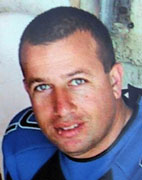|
San
Diego Jewish World
killing Oshri Oz, 36, a computer
technician
|
|||||||
|
5/27/07
SDJW Report (click on headline below to jump to the story) International and National
killing Oshri Oz, 36, a computer
technician
Israeli University Research |
company a few years ago, he continued
to service its computers, and came to Sderot several times a week.
Medical Center in Ashkelon where he died shortly afterwards. Avi Tiger, an MDA paramedic who treated Oshri on the site, knew him since childhood. They were part of a closely knit group of friends, of the Tzofei Yam scout troop, who have stayed in contact for over 25 years. Oz is survived by his wife Susanna, in the sixth month of pregnancy, 3-year-old daughter Danielle, mother and two sisters.
The rocket alert system was activated in
Sderot just before 7 am on Sunday, followed by sounds of explosion. Sappers and
firefighters found the remnants of a Qassam rocket between an apartment building
and a new community center, which suffered slight damage. Children waiting for
buses to take them to schools out of town panicked upon hearing the alert system
and the explosions. |
|
|||||
|
Rep.
Wasserman-Schultz helps to collect Wasserman Schultz’s event at Florida Atlantic University provided local high school students an opportunity to interview local U.S. Veterans and gather first-hand accounts of their experiences from World War I to the current Afghanistan and Iraq conflicts. Each interview was videotaped and sent to the Library of Congress to be archived. Veterans or those who contributed to the war effort (Red Cross, “Rosie the Riveter,” U.S.O., etc.) were encouraged to come and share their stories and to bring photos, medals, artwork or letters that relate to their service for their country. The congresswoman said the materials will be digitally scanned and stored along with their interview in an archive held by the Library of Congress in Washington, DC and will be accessible on the internet. The foregoing article was based on information provided by Congresswoman Wasserman-Schultz’s office.
HAIFA
(Press Release)—Your baby, who used to play so nicely, suddenly seems less
attentive and appears to have difficulty concentrating. There could be a
good reason for this—it could be that he is beginning to walk. New research
at the Faculty of Education of the University of Haifa found that a baby's
learning to walk affects his play skills. The research was based on the assumption that the domain of play reflects the interaction between the child and his environment. When a child begins to walk, the way in which he experiences his environment changes. This change may be manifested in the way he plays. In order to examine this assumption, sixty children were evaluated at ages 10, 12 and 14 months. The researcher measured the child's play using three parameters: persistence and engagement in a specific task while playing with objects, attention span and concentration and the level of sophistication of object play. Results revealed a tendency to a decrease in the child's level of persistence, concentration and attentiveness at the onset of walking in comparison to the pre-walking stage. This "regression" in play behavior was short-term since the child's persistence and attentiveness tended to increase and improve after mastering the initial stages of independent walking. The researcher also witnessed a regression, albeit not decisive, in task-directed behaviors during this period.
The
researcher also found differences between the level of play of children who
had already begun to walk and children of the same age who were not yet
walking. Those children who had mastered independent walking exhibited a
higher level of play than their non-walking peers.
The
foregoing story was provided by the University of Haifa. HAIFA—Technion researchers, in cooperation with a group of researchers from Rensselaer Polytechnic Institute (RPI) in Troy, New York, have found an original way to significantly improve bonding and adhesion between various materials. This was revealed in the latest issue of the prestigious scientific journal Nature.
Prof. Moshe Eizenberg of Technion’s Materials Engineering Department and
the Russell Berrie Nanotechnology Institute, together with Prof.
Ganapathiraman Ramanath from RPI, have found
an innovative way to bond and adhere materials using nanolayers. These
layers are short, organic chains, each one
containing groups of atoms that bond to the appropriate surface. The importance of this discovery to microelectronics translates into improved device performance and greater reliability. In addition, this discovery could be used in nanometric devices that contain organic molecules and need to withstand high temperatures.
The joint research was supported
by the US-Israel Binational Science Foundation for three years. The Water & Contaminants Monitoring System (W&CMS) provides, for the first time, a simple, fast and cost-effective monitoring system that providing real time data on water and contaminate transport in the areas above the level of ground water, known as the vadose zone. The vadose zone includes the upper soil and rock layers which lies between the land surface and the aquifer water table beneath. Both water and contaminants must pass through the vadose zone prior to entering the water aquifer. According to Dahan, most sources of man-made pollution originate on land surface right above the vadose zone, including industry, intensive agriculture, landfills and waste lagoons. Unfortunately, vadose zones are not hydraulically isolated – and as a result water and contaminants may rapidly migrate through downward towards the water table and pollute the groundwater. There is evidence that even the thickest vadose zones have limited ability to buffer against the contaminants. (jump to continuation)
*Syndicated columnist Gene
Weingarten of the Washington Post has invented a new phrase "Googlenopes"—word
combinations that even the powerful Google search engine can't find
because they don't exist until someone like Weingarten writes a column.
His first example: "unintelligent Jew."
His
column appears in today's San Diego Union-Tribune.
Water Pollutants...
Monitoring programs for ground water protection from pollution hazards were traditionally based on information pulled from groundwater. This monitoring method is well-established around the world, and there are even laws in several countries requiring this type of groundwater monitoring for potential polluters. But the method is flawed. The penetration into the groundwater for monitoring may turn out to cause irreversible damage and cleaning of the contaminated ground water in complicated and extremely expensive. Moreover, this could not provide any protection to groundwater since identification of contamination in groundwater is by definition too late as groundwater is already contaminated. Note, the so far no groundwater remediation anywhere around the glob has been successful, and no aquifer has ever been fully remediate, in spite of the multi-billion dollar investment in remediation actions. Therefore, monitoring of contaminate transport in the vadose zone, long before it reached the groundwater is the key to groundwater protection, and removing contaminants from vadose zones is a logical approach to preserving the quality, and therefore, the quantity of groundwater resources. Yet, accurate and affordable monitoring technology hasn’t been available -- until now. The newly developed system is designed to provide continuous measurements of soil water content and water potential in the vadose zones.“The W&CMS has been successfully installed in several places Israel, as well as in other countries where it has demonstrated that it can enhance the overall protection of human the environment and particularly groundwater,” explains Dahan, “by providing earlier and better control of downward water flow and contaminant migration towards the groundwater.” Fighting groundwater pollution is critically important to many activities, including those associated with agriculture, forestry, hydrology, pollution abatement and engineering.
In recent years, there has been increased environmental awareness and as
a result, a greater demand for this kind of pollution monitoring. Solid
waste dumps, petroleum stations, waste water treatment plants, chemical
industries and many more other activities that might pollute soil and
groundwater all need close and careful inspection. The availability of
W&CMS system will give governments as well as environmental protection
organization more power to demand that potential polluters stay within
guidelines and better protect the quality of water and as a result, the
quality of life. |
|||||||
 He was driving in Sderot at about 9:30 in the morning when a
Qassam rocket fell just 30 cms from his car. Fatally wounded, he was evacuated to the Barzilai
He was driving in Sderot at about 9:30 in the morning when a
Qassam rocket fell just 30 cms from his car. Fatally wounded, he was evacuated to the Barzilai
 The
results of Dr. Mizrahi’s groundbreaking work appeared in the online edition
of Nature Neuroscience. Using special microscopic imaging techniques,
combined with virus gene technology, Dr. Mizrahi was able to develop an
experimental model to study development of neural dendrites in vivo. The
dendrites are the string-like extensions of the neuron that spread out to
reach other neurons and serve as the points of communication between the
neurons.
The
results of Dr. Mizrahi’s groundbreaking work appeared in the online edition
of Nature Neuroscience. Using special microscopic imaging techniques,
combined with virus gene technology, Dr. Mizrahi was able to develop an
experimental model to study development of neural dendrites in vivo. The
dendrites are the string-like extensions of the neuron that spread out to
reach other neurons and serve as the points of communication between the
neurons.  Jews
in the News
Jews
in the News
 -----------------------------------------------------------------------------------------------------------------
----------------------------------------------------------------------------------------------------------------- U.S.-ISRAEL
CONNECTIONS— Bar Ilan University on May 24 recently conferred its "Guardian of
Zion" Award on Norman Podhoretz, editor at large of Commentary
Magazine. Since 1997 when the award for strengthening and perpetuating Jerusalem
was given to Elie Wiesel, the annual winners have been A.M. Rosenthal,
Sir Martin Gilbert, Cynthia Ozick, Charles Krauthammer, Ruth Roskies Wisse,
Arthur Cohn and Daniel Pipes. ..
U.S.-ISRAEL
CONNECTIONS— Bar Ilan University on May 24 recently conferred its "Guardian of
Zion" Award on Norman Podhoretz, editor at large of Commentary
Magazine. Since 1997 when the award for strengthening and perpetuating Jerusalem
was given to Elie Wiesel, the annual winners have been A.M. Rosenthal,
Sir Martin Gilbert, Cynthia Ozick, Charles Krauthammer, Ruth Roskies Wisse,
Arthur Cohn and Daniel Pipes. ..